Understanding age-generational real estate statistics, preferences, trends, and behaviors provides valuable insights into the diverse needs and priorities that shape the housing market. Consider how the age of a prospective buyer can impact that buyer’s journey. Age and generational differences are driving new trends and behaviors in the market. The Close dives deep into statistics surrounding these trends and behaviors to provide real estate agents with actionable insights into how age impacts the market.
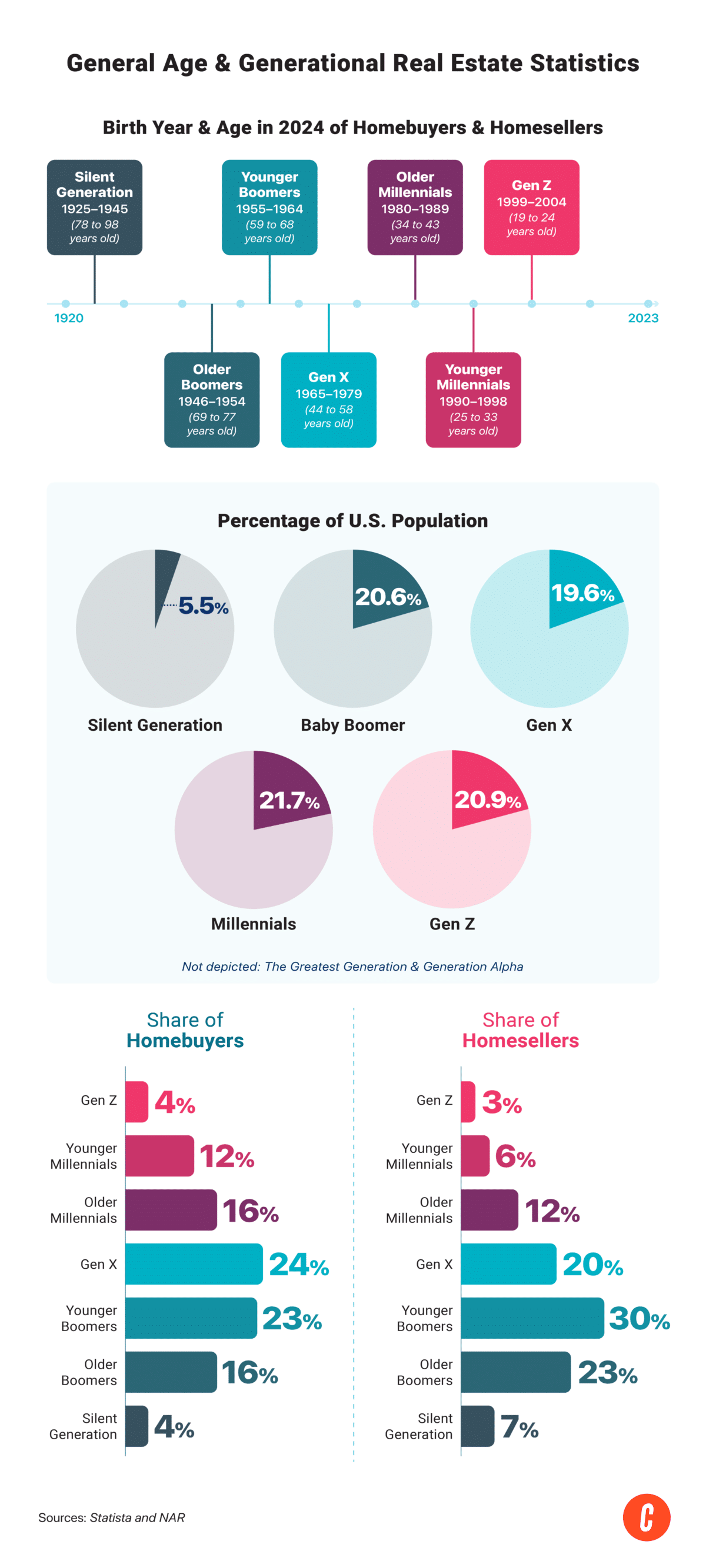
Gen Z (1999-2004)
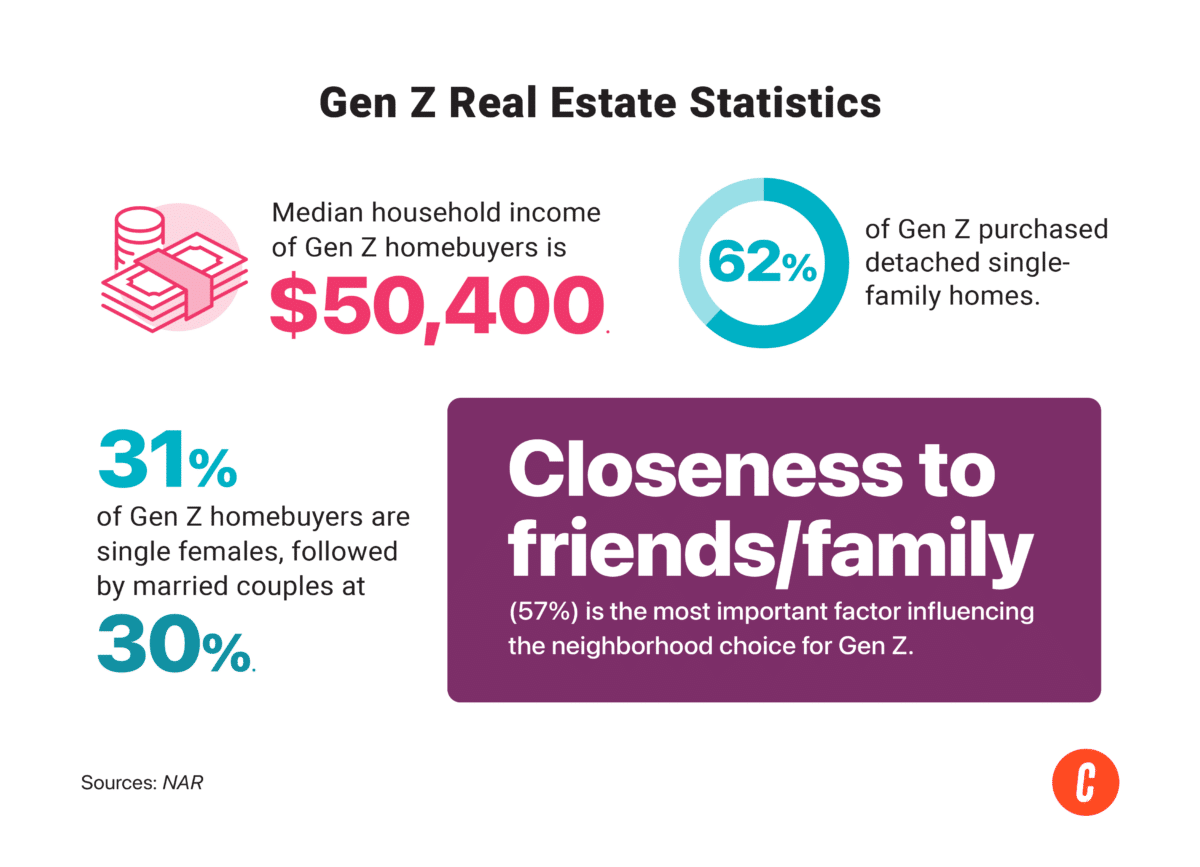
According to the National Association of Realtors (NAR) 2023 report, Gen Z comprised 4% of buyers and 3% of sellers in the US. The age and generational real estate statistics show they have the highest percentage of single female buyers at 31%. They also have the lowest median household income of $50,400, and 62% purchased a detached single-family home with a size of 1,501 to 2,000 sq ft (42%), three bedrooms (70%), and energy-efficient appliances (39%).
Notably, 30% of Gen Z real estate buyers moved directly from their family members’ homes into homeownership. A convenient location near friends and family was most important to this group when buying a home. In addition, 22% of buyers purchased a house to care for aging parents.
Impact of Gen Z on the Real Estate Market
Now:
- Many Gen Zers have financial difficulties, such as debt from school loans, which can hinder their ability to buy a home. They know that housing costs are outpacing pay growth and homes are becoming more expensive. That is why those Gen Zers who can afford to buy are eager to do so.
- Therefore, most Gen Zers prefer purchasing a home at a higher price than paying steadily rising rent. Gen Z has begun to make inroads into the housing market in mid-sized, comparatively cheap states like Illinois, Nebraska, and Minnesota.
In the future:
- Larger homes, better schools, and a more family-oriented lifestyle may cause Gen Z to move toward suburban living once they grow older, make higher wages, or start families.
- The real estate agents who help Gen Zers climb on the property ladder could be rewarded with lifelong clients. They’ll need hand-holding as they navigate their first purchase. And if you nurture them, they’ll return to you when they’re ready to upgrade, want to buy investment properties, assist their parents in selling their homes, or want to help their kids become homeowners.
Younger Gen Y aka Younger Millennials (1990-1998)
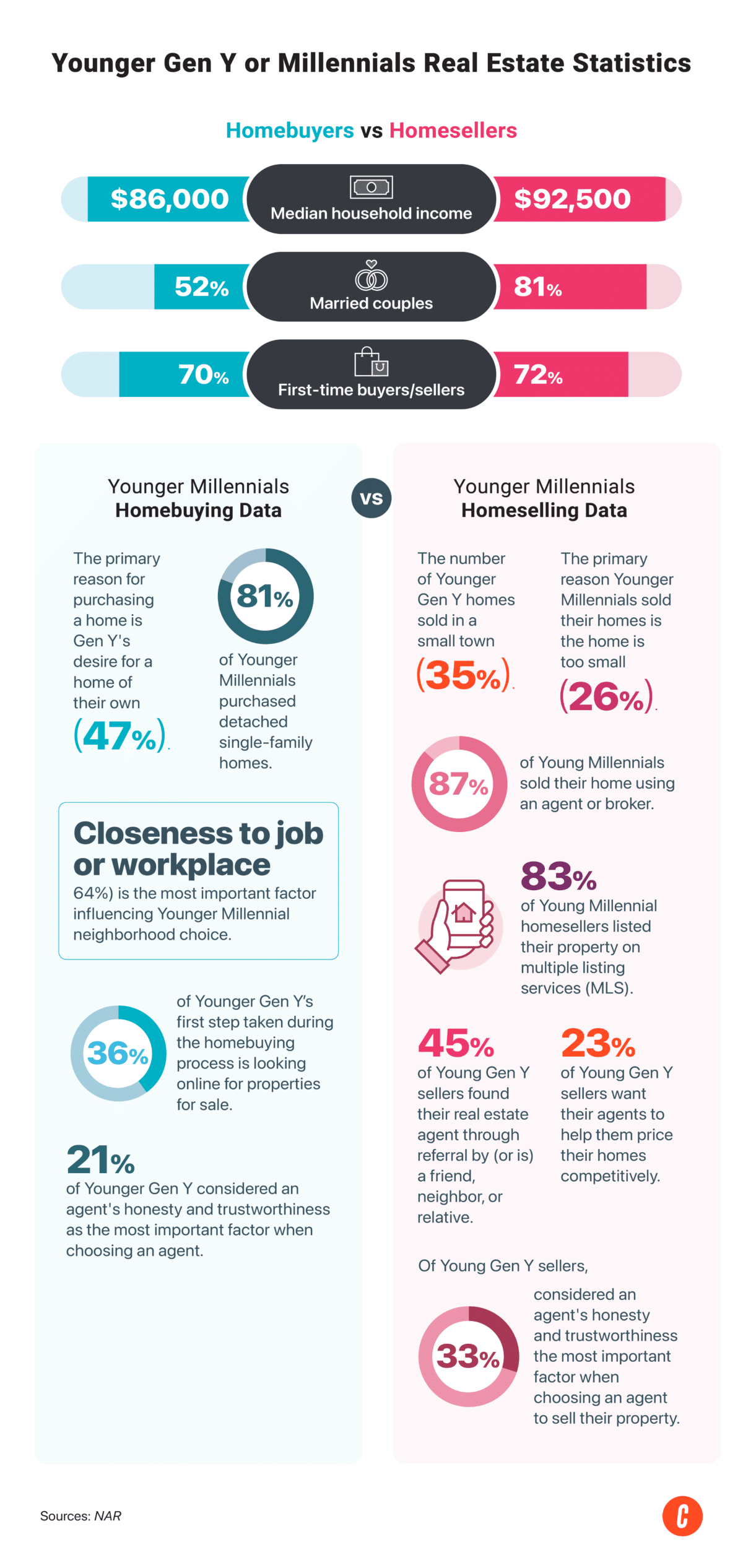
According to millennial home buying trends, younger millennials make up 12% of homebuyers and 6% of homesellers. Among those homeowners, 70% are first-time homebuyers, and 72% are homesellers. They had the highest share of unmarried couples (20%) buying homes, and 52% are married couples. This generation was the most educated age group, with 80% holding at least an associate’s degree.
When considering location, the convenience of a job was most important to this group when buying a home, and they considered commuting costs to be the most important environmental feature at 35%. Younger millennials only viewed one home online without seeing it in person. Additionally, 22% of this age group received down payment help through a gift or a loan from a friend or relative. Agent referrals by friends, neighbors, or relatives were highest among younger millennial buyers (50%).
Impact of Younger Millennials on the Real Estate Market
Now:
- Younger millennials are impacting the real estate market as they become first-time homebuyers and look for urban living accessible to their workplace. Some of this age group may put off homeownership or alternate housing options due to affordability issues driven by student loan debt and increasing housing costs. The impact of low inventory, remote work, and their preferences for sustainability and well-being are shaping the features and locations of their homes.
In the future:
- Younger millennials continue to impact the real estate market of the future significantly. Due to the high percentage of first-time homebuyers and the growing suburban living trend, demand in those areas will be driven by their preferences for larger homes and better school and transportation access. The rise of eco-friendly communities and smart home features will be influenced by their focus on sustainability and technological integration.
- Furthermore, their dependence on friends and family for financial support highlights the value of social networks in their home-buying decisions. It emphasizes the relevance of referrals in the real estate market. In addition, due to higher home ownership costs, rent prices are increasing much faster than purchasing. This trend will lead to lower homeownership rates and vacancies in the rental market.
Older Gen Y aka Elder Millennials (1980-1989)
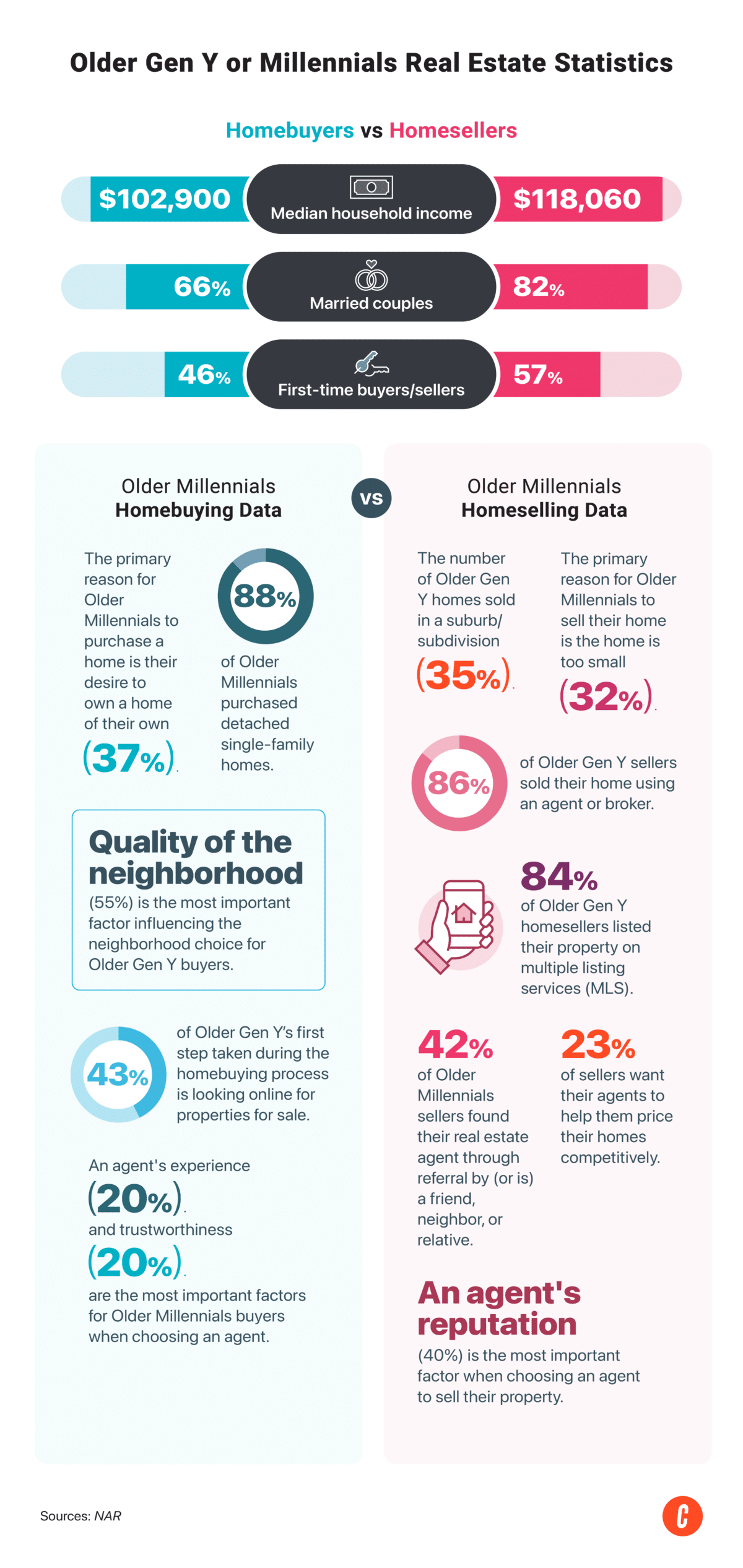
Elder millennials make up 16% of all homebuyers, and 46% are first-time homebuyers. This age group also has one of the highest shares of married couples (66%), with a median household income of $102,900. In addition, 70% of older millennials have at least one child under 18 residing in the home.
When looking for a home, the NAR’s age and generational real estate statistics reveal that a detached single-family home, the quality of the neighborhood, and overall affordability are the most important things for elder millennials. Despite these generational trends in real estate, they are most likely to relocate 15 miles from their previous home. This generation also used their savings (57%) for their down payment for home purchases.
Married couples were the highest population among elder millennial homesellers at 82%. Moreover, 76% used a referral or the same real estate agent they had previously worked with, and 83% were the most likely to recommend their agent. Those selling their homes are likely doing so because their current home is too small (32%), because of a job relocation (14%), or because their neighborhood has become less desirable (13%).
Impact of Elder Millennials on the Real Estate Market
Now:
- As elder millennials start buying residential real estate, technology plays a significant role in their home search. This generation uses mobile or tablet devices to look up properties, view them, and contact real estate agents. In addition, they are progressively purchasing larger first houses than earlier generations. They were among the groups buying homes during the COVID-19 pandemic when house showings were only conducted online. Plus, older millennials typically favor living close to their jobs.
In the future:
- Elder millennials are anticipated to play a significant role in the future of the real estate market. As many homebuyers are married couples with a high median household income, their preferences for detached single-family and family-friendly homes, neighborhood quality, and affordability will continue to drive demand in these sectors.
- Additionally, their dependence on savings for down payments, preference for referrals and working with past real estate agents, and tendency to recommend their agents all emphasize the value of personalized and trusted relationships in real estate transactions.
Gen X (1965-1979)
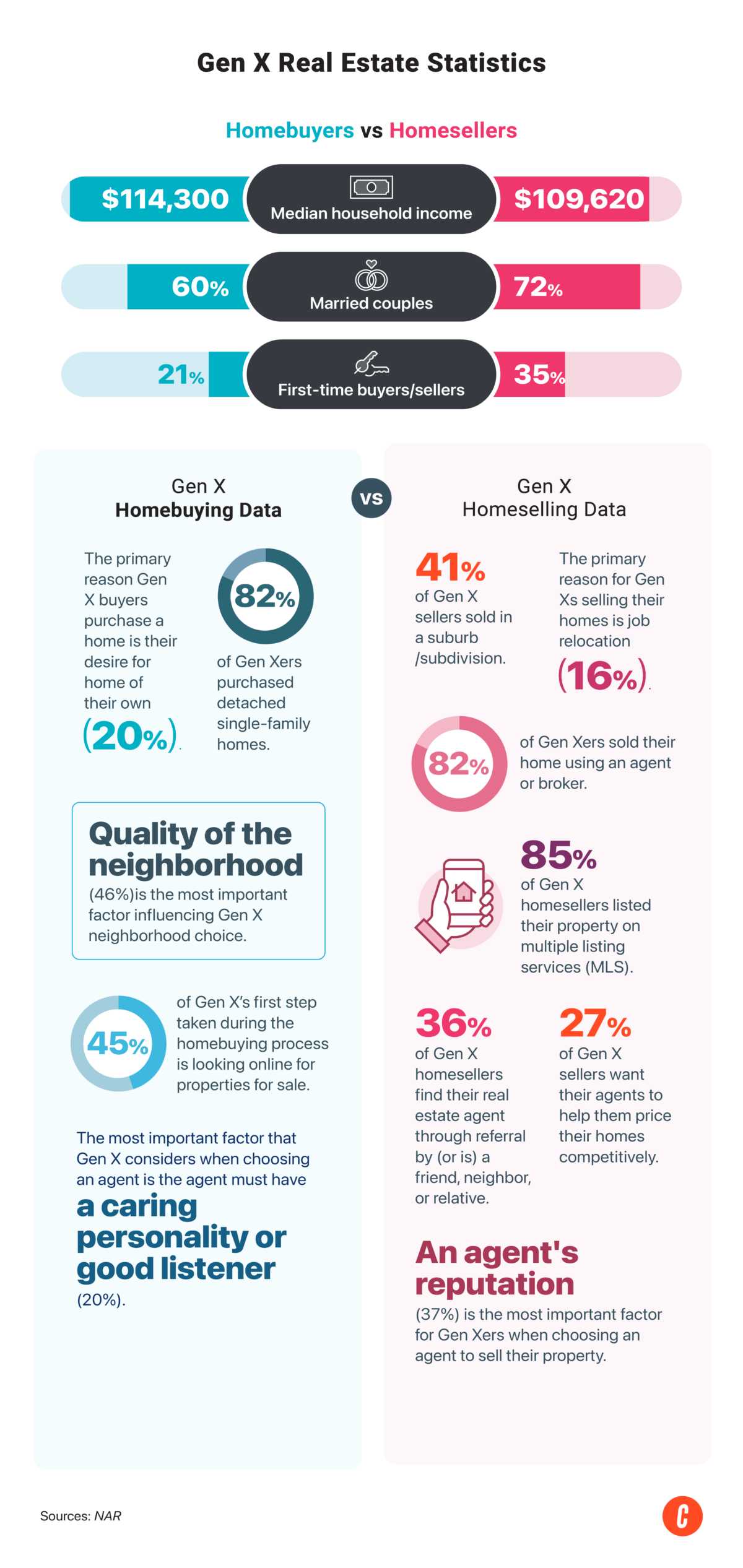
Gen Xers comprised the highest percentage of homebuyers at 24%, of which 21% are first-time homebuyers. This group remains the highest-earning homebuyer group, with a median income of $114,300. They were the second group most likely to purchase a multigenerational home at 17%, behind the older boomers at 18%. When looking at the reason to buy a house, they were more likely to purchase closer to jobs, school, transit, or a job relocation or move.
Aside from these, Gen X prefers to buy a detached single-family home with 2,001 to 2,500 sq ft, three bedrooms, and two full bathrooms. As for home selling generational trends in real estate, 35% are first-time sellers, and 65% are repeat sellers. This age group sold their previous homes for job relocation and to move closer to friends or family.
Impact of Gen X on the Real Estate Market
Now:
- Of all the generations, Gen Xers are in the best position to afford homes in the current housing market. They were well-established in their careers before the property market crash and subsequent recession in 2001. Gen X found housing relatively more affordable because they had made more money or savings than previous generations. As a result, Gen X is currently quietly dominating the housing market.
In the future:
- Gen X will continue to have the highest percentage of homebuyers who prefer homes with extra rooms and spaces for multigenerational living, such as caring for adult children and aging parents.
- Gen X may be an ideal demographic for real estate agents to target when looking for homeowners interested in upgrading to a larger and better home. The agent might receive two commission checks for assisting a single client in selling their existing house and purchasing their new one.
Younger Boomers (1955-1964)
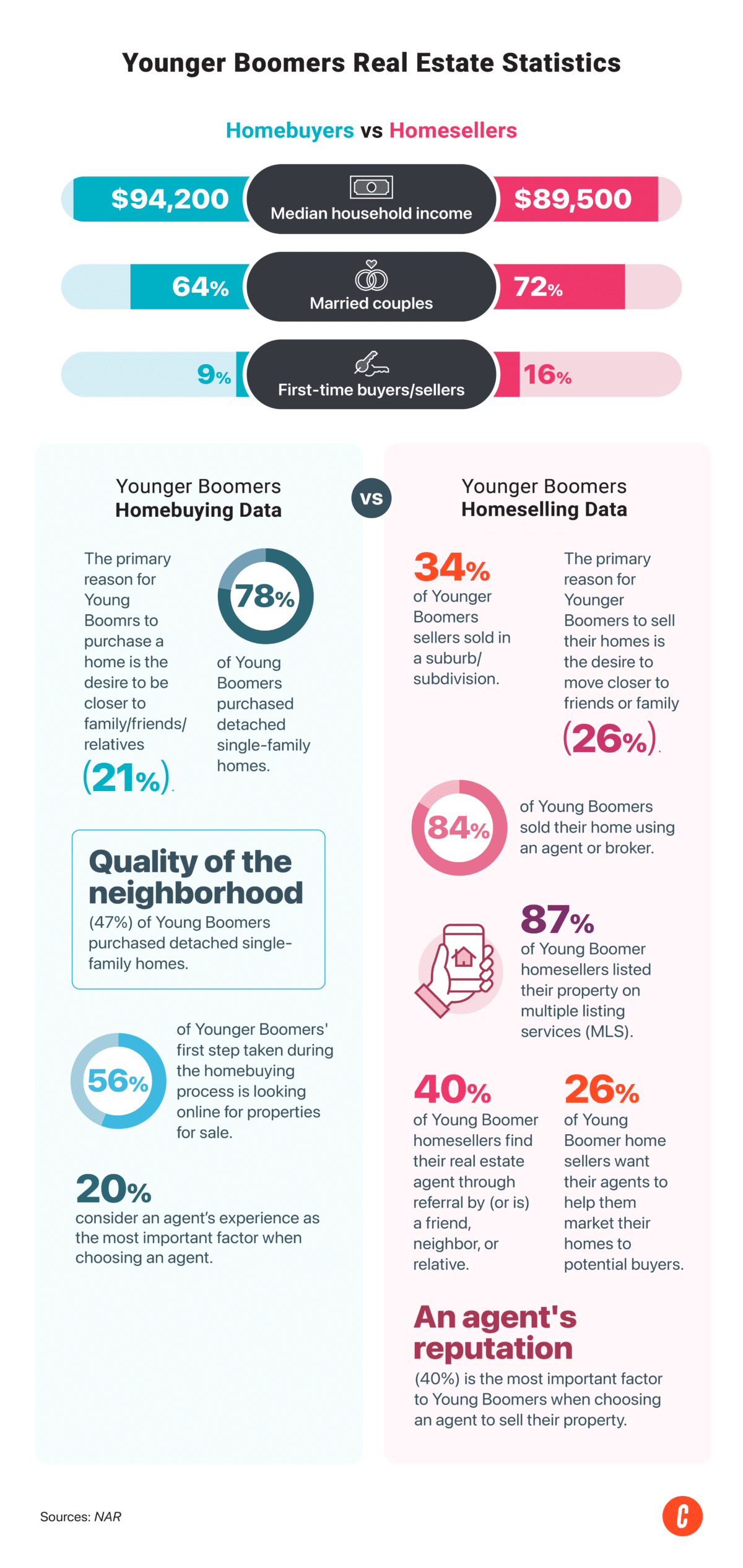
Younger boomers had the second-largest share of buyers at 23% and had a median income of $94,200. This generation typically purchased detached single-family homes in rural areas to be closer to family, friends, and relatives. Also, they are more likely to buy a new home to be able to choose and customize design features. As for the homebuying process, younger boomers contacted a real estate agent as a first step more often than other generations. Plus, 90% of younger boomers purchased their home through an agent.
Younger boomers comprise the largest share of sellers, at 30%, and have a median income of $89,500. In addition, 84% of the sellers are repeat sellers, and only 16% are first-time sellers. The age-generational real estate statistics also show that younger boomers typically owned their homes for 11 years before deciding to sell their property.
Impact of Younger Boomers on the Real Estate Market
Now:
- Many younger boomers choose to downsize from their larger family homes to more compact living as they enter retirement. Some want a property that requires less maintenance and is easier to manage, while others like easy access to medical facilities and social activities within the community to accommodate their needs. In any case, the demand for smaller homes—predominantly single-family, condominium, and townhouse properties—is rising due to this trend.
In the future:
- Younger boomers will continue to be active homebuyers and sellers, as becoming a homeowner reflects on their accomplishments and future plans. The migration towards states with warmer climates, like California or Florida, also begins at this age. Therefore, real estate agents must focus on those locations and home features to accommodate the younger boomers’ needs and wants.
Older Boomers (1946-1954)
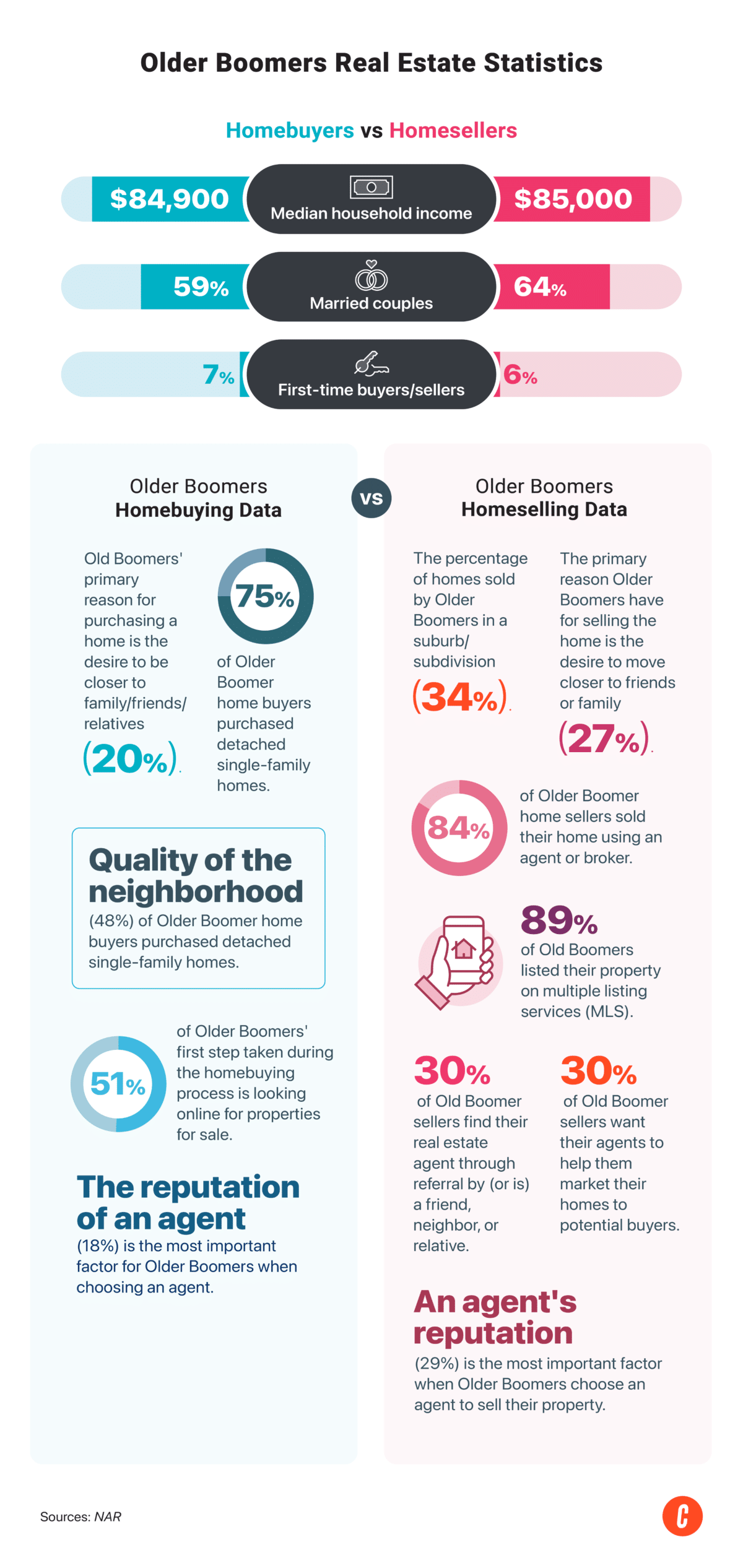
Older boomer homebuyers tend to be married couples (59%) with a moderate income level of $84,900. They prefer detached single-family homes, prioritize the quality of the neighborhood, and are motivated by a desire to be closer to family and friends. Additionally, they increasingly use online platforms for property search (51%), and the agent’s reputation plays a significant role in their decision-making process (18%).
Moreover, older boomer homesellers tend to be experienced, as 94% are repeat sellers. They sold their homes in a suburb/subdivision (34%) for personal reasons, such as moving closer to friends or family (27%). The majority of older boomer sellers (84%) sold their homes using an agent or broker, emphasizing personal referrals (30%) and the agent’s reputation when making choices (29%).
Impact of Older Boomers on the Real Estate Market
Now:
- Older boomers currently feel the need to buy or sell, and an increasing number of them prefer to downsize for reasons that include health difficulties, the death of a spouse, financial concerns, or retirement. However, some older boomers opt to live with family members, resulting in multigenerational households.
- Multigenerational family arrangements have become more prevalent as elderly people start to move in with their adult children after selling their homes to get the support they require and desire. As a result of this trend, the need for larger homes that can house extended families is increasing.
In the future:
- It’s clear that older boomers will continue to significantly impact the housing market. This age group, which makes up one of the largest shares of homesellers, has successfully taken advantage of market prices to sell their properties for a higher price. We can expect them to persist in buying and selling their properties, desiring to upgrade or downgrade their current living situation.
Silent Generation (1925-1945)
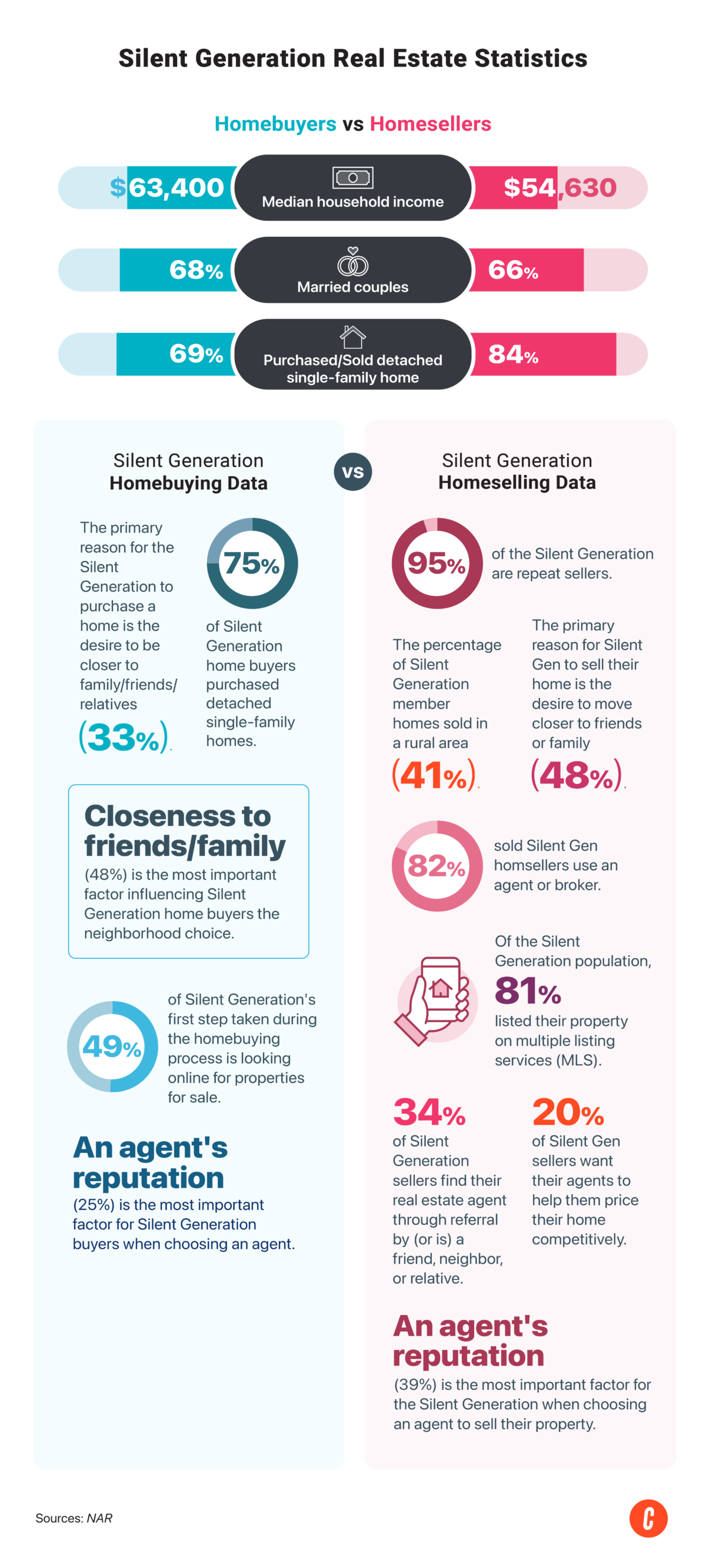
With a 4% share, the Silent Generation was one of the smallest buyer groups. The primary reason for their purchases was to live near friends and family, and 12% were in senior-related housing. Compared to other groups, they were more likely to base their neighborhood choice on how close it was to medical facilities. This age group also had the highest percentage of military veterans, with 41%. Most buyers from the Silent Generation mentioned that they might have to move because of a family member’s health, but they still planned to stay in the property for 15 years.
Silent Generation buyers were most likely to work with an agent they had previously used to buy or sell a home, and an agent’s reputation was most important to them. As for home selling, this age group only has a 7% share of all sellers, of which 95% are repeat sellers. Also, 34% of Silent Generation sellers reduced their asking price at least once.
Impact of Silent Generation on the Real Estate Market
Now:
- The Silent Generation’s impact on the real estate market will persist, albeit not as buyers or sellers, but rather due to the homes their children inherit. If they prefer to buy, this age group moves closer to family and friends. Properties that will make their life easier while maintaining a high level of privacy are ideal for them as they age and may require extra attention.
In the future:
- As the Silent Generation ages, they will gradually transition out of homeownership, leaving chances for younger people to enter the real estate market. However, since the Silent Generation is composed of experienced and repeat homesellers, selling their homes later in life affects home inventory availability and potentially drives up prices.
Bringing It All Together
It becomes evident that the preferences and priorities of each generation significantly shape the real estate market—from the demand for sustainable and technologically advanced homes among millennials to the downsizing trends of the Silent Generation. By recognizing and adapting to the evolving needs of diverse age groups, real estate professionals can position themselves for success in a market that continues to be influenced by the nuanced preferences of each generation.







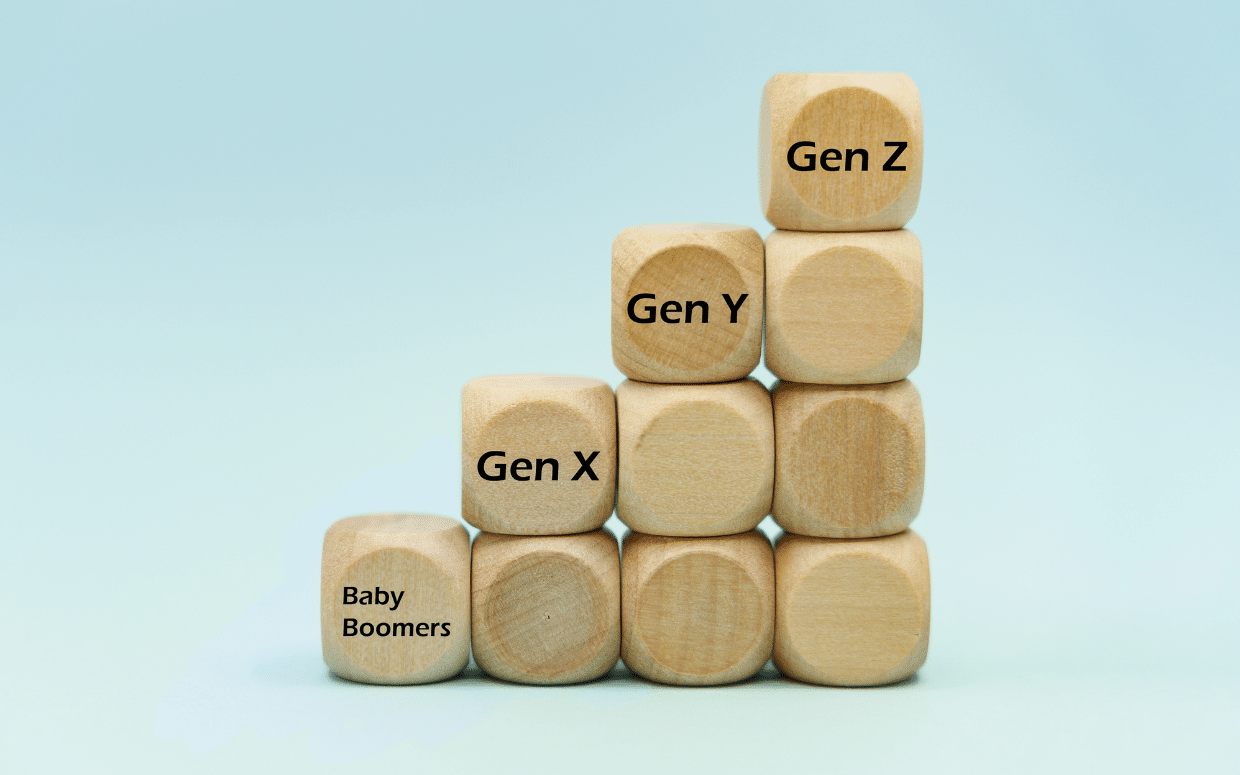



Add comment